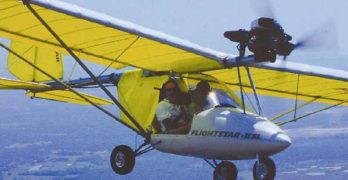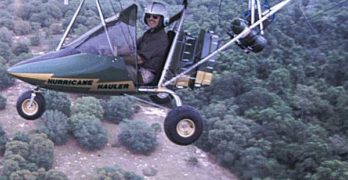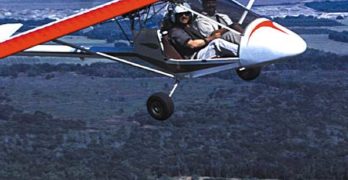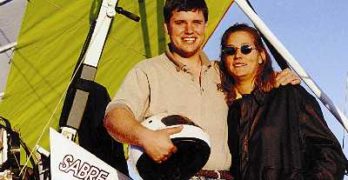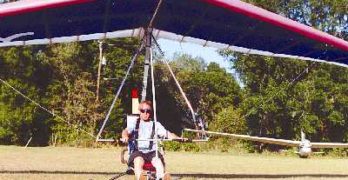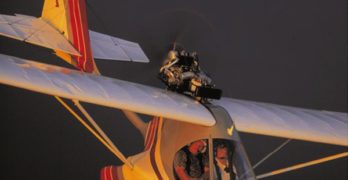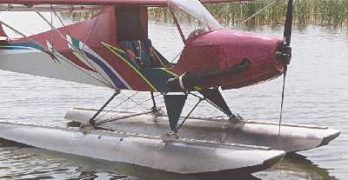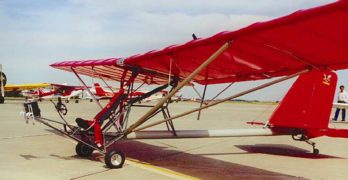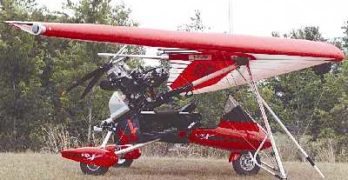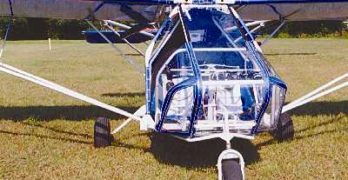Since Tom Peghiny and partner Spark Lamontagne first lightened the Flightstar and named one model the II SL (for “Sport Light”), they haven’t been able to sit still and simply admire their work. From our first pilot’s report on the SL 3 years ago,1 the two have tweaked and adjusted the model to find even better qualities.
A new front and aft fairing are part of the package, and the latter you might notice rather quickly. Virtually all the rest of the improvements are subtle things. In fact, that word is a hallmark of Flightstar innovation.
No surprise then that the company should adopt “New and Improved” as its new advertising headline to assure you know about the changes.
Better and Better
I’ve followed the Flightstar from its first flight, when it wasn’t even the Flightstar. This design – which once crossed the Atlantic – is from the inventive mind of Swiss national Hans Gygax, and became the rather gaudy 440ST.
Search Results for : CT AND hand control
Not finding exactly what you expected? Try our advanced search option.
Select a manufacturer to go straight to all our content about that manufacturer.
Select an aircraft model to go straight to all our content about that model.
HKS Hurricane Hauler
Last year, the 60-hp HKS 700E 4-cycle engine burst on the ultralight scene with more impact than I’ve noted since Rotax established itself as the engine of choice for ultralight enthusiasts. Among those embracing the new designed-for-light-aircraft powerplant was HY-TEK Hurricane, manufacturer of the Hurricane brand.
In the years since Mike Kern took over the Hurricane, he has shown savvy about the ultralight marketplace. He was able to see where he could enlarge his potential customer base, and his quick acceptance of the newly-available engine proves this.
Despite years of good success with high power-to-weight ratio 2-stroke engines, lots of would-be ultralight buyers remain unconvinced. A Hurricane with a 4-stroke gives HY-TEK the chance to appeal to those buyers and more.
In addition to ultralight enthusiasts looking for more, Kern sees a market in those hordes of Cessna drivers who want something different. A new Hurricane with the HKS 700E fitted is priced below all but the most worn-out general aviation planes, and can be more fun than operating a heavier aircraft that was built as a transportation device rather than a joy machine.
New Kolb Aircraft
Sometimes I’m amazed that we’ve now got ultralight pilots buying engines that cost more than $10,000. Twenty years ago, Eipper Formance (Quicksilver) sold complete ultralights that cost $3,499. Even in the ’90s, many complete ultralights – engine and all – cost less than the price of a Rotax 912 4-stroke engine on its own. One that meets that description is Kolb Aircraft’s Mark III with a 50-hp Rotax 503 dual carb 2-cycle engine.
Nonetheless, the 81-hp Rotax 912 has invaded the realm of what is loosely called “ultralight” flying. Of course, a Rotax 912-powered aircraft simply cannot be used on a single-place Part 103 ultralight. And any 2-place plane with a 912 is less likely to qualify as an ultralight trainer under the training exemption to FAR Part 103; the big engine may push the plane too fast and could make it heavier than 496 pounds (the ultralight trainer empty weight limit).
Aeros Venture from Sabre
Only a little more than 10 years ago, the wall fell in Berlin, Germany and Communism collapsed in the USSR. Before these momentous events, few Americans knew anything about the Ukraine (which was part of the USSR) and even those who did were largely unaware of its ability to produce aircraft.
Yet by the mid-1990s, some Americans became aware of a Ukrainian company named Aeros. One man became an importer of their hang glider line. G.W. Meadows and his Thermal Riding Vehicles business sold so many hang gliders from the former Soviet satellite that the American market leader, Wills Wing, had to drop prices to remain competitive with the lower cost hang gliders from eastern Europe.
In this article I’ll review the Venture, the newest Aeros model for the American ultralight market. But this new Aeros ultralight follows the Aeros Antares (once known as Graffiti), reviewed in the December 1997 issue of Ultralight Flying!
Sky Cycle
In a world of ultralights populated with powered parachutes, powered paragliders, weight-shift trikes, and all manner of 3-axis ultralights, why not a powered hang glider? Why not return to our roots?
For those too new to the scene to remember, ultralights started out as powered hang gliders. John Moody, the man widely known as the “Father of Ultralights,” first motorized and flew a hang glider called the Icarus II (which evolved into the Easy Riser). Moody’s first ultralight, back in the mid-1970s, had no landing gear and no tail because those appendages weren’t on hang gliders then, or now.
After Moody’s early work – plus that of others in the hang gliding and ultralight community – other pioneers began adding power packages to more conventional hang gliders. The Easy Riser Moody flew had good performance but didn’t break down as efficiently as the fully-foldable “flex wings,” as they are commonly known today.
Interplane Skyboy
In May 2000 I wrote about the imported Sabre Aircraft Venture trike. That model from the Ukraine was quite impressive and worthy of your consideration. Now from the Czech Republic comes the Interplane Skyboy. Should Yankee ultralight manufacturers show concern? Yes, I’d say so. However, American pilots – while perhaps showing an interest in imported designs – don’t seem to buy a lot of these planes. Or do they?
In recent years we’ve seen trike sales soar. Few industry leaders predicted this despite the persistent efforts of the big European trike builders. Many veterans claimed trikes would never have an impact on the majority of pilots who prefer 3-axis controls. They are being proved wrong, for now anyway.
A key reason that holds back U.S. purchases of imported aircraft has to do with local support. Even a good importer can’t always control when spare parts are available. Interplane solves this dilemma in an interesting way and with American style: they bought the Czech Republic factory.
Flying Sky Raider
Since Flying K Enterprises’ Sky Raider arrived on the scene 4 years ago, the ultralight design has achieved excellent success in the market selling more than 140 kits (not including the 65 or so fuselages shipped to SkyStar Aircraft which they use for their Kitfox Lite). However, the company behind the Sky Raider design has suffered in nontechnical ways.
Original Flying K principals brothers Ken and Stace Schraeder split up and started separate companies making ultralights. Then, only months after the split, Ken Schraeder was killed while flying a Sky Raider (see “Flightlines – Kenny Schraeder Killed in Crash,” April ’00 Ultralight Flying! magazine).
Despite these setbacks, the Sky Raider flies onward. In fact, Flying K Enterprises seems to be healthy and energetic despite the twin losses.
When the company shows their Sky Raider floatplane model and an example of their coming 2-seater, crowds often flock around the ultralights. I was full of anticipation to see how the floatplane would fly.
Rans Stinger
The original concept and final design Stinger appear to share only two things. First is the name – S-17 Stinger – and the second is the little bumblebee logo. In every other case I could discern, the finished Stinger is a totally new design from Randy Schlitter’s original idea.
Stinger version two flew for the first time on September 10, 1999. Barely a week later, I found myself aloft in the new ultralight. Normally, I’m not anxious to jump into a manufacturer’s brand-new design. I much prefer waiting until they have the design fully worked out.
However, Randy Schlitter has an excellent reputation for airplanes that seem to fly right off the drawing board (or out of the CAD program these days). He’d put some hours on the Stinger and had given it his blessing. I observed him fly it first and by all measures, it appeared to be ready for evaluation flying.
Airborne Streak
I am amazed. I didn’t think AirBorne Australia could do it, but they made their top-of-the-line wing called the Streak 2000 handle dramatically better than previous iterations.
Published in Light Sport and Ultralight Flying
Seating
2, tandem
Empty weight
476 pounds
Gross weight
992 pounds
Wingspan
32.4 feet
Wing area
167 square feet
Wing loading
6.2 pounds per square foot
Length
11.3 feet
Height
11.5 feet
Fuel Capacity
18.5 gallons
Kit type
Fully assembled
Airworthiness
Certified SLSA
Build time
Minor assembly from shipping container
Standard engine
Rotax 5821 or 9122
Power
66 hp at 6,500 rpm
Power loading
12.4 pounds per hp
Cruise speed
(middle hole) 45-60 mph (forward hole) 75 mph
Stall Speed
39 mph
Never exceed speed
93 mph
Rate of climb at gross
770 fpm
Takeoff distance at gross
590 feet
Landing distance at gross
575 feet
Range (powered)
350 miles
Fuel Consumption
3.3 gph
Notes:
1also available with the Rotax 503 engine (2000 Article).2Rotax 512 UL (2006 Article).
Golden Circles
As with many ultralight aircraft brands, when single-seaters become dual machines the machine gets heavier and more complicated. And when ultralights get heavier, they often don’t work quite the same.
Since flight school operators and pilots wanting to carry a friend request 2-seat capability, ultralight manufacturers respond, trying to get as close as possible to single-seater feel. But this isn’t simple. Two-seat ultralights often give up some of the qualities that make a single-seater pure joy to fly.
However, designers make constant refinements in ultralights.
Look around at airshows. Most of the ultralights on display these days are well-built machines with lots of custom hardware. Nearly every one got that good employing the CANI approach – Constant And Never-ending Improvement.
Golden Circle’s T-Bird II is one model that has seen subtle but noticeable improvements that make the breed better. Even to those intimate with the Iowa ultralight producer, these changes may evade your inspection.
- « Previous Page
- 1
- …
- 55
- 56
- 57
- 58
- 59
- …
- 62
- Next Page »


